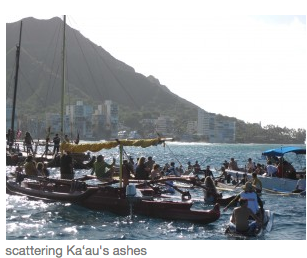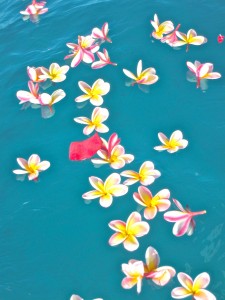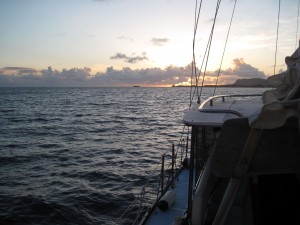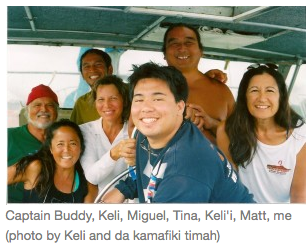Haʻikū Stairs, otherwise known as the Stairway to Heaven
This past Sunday morning at 2:30 a.m. I met a friend to drive to a locked gate at one of the entrances to the private property where the trail begins that leads under the H-3 freeway to the base of the Haʻikū ladder. The locked gate may prevent cars from entering but there is a well worn foot path around the side of it. While waiting for the others in our group to arrive, two groups came in to hike the stairs, which finally convinced me that this was not just a rude joke to get me out of bed at 2 a.m.! The reason for the early start is that a guard is posted at the foot of the latter to prevent people from going up. The guard used to start work at 5 a.m., but evidently when hikers figured that out and started coming earlier, he started coming an hour earlier. We therefore had to get past the guard station by 4 a.m.
It was a moonless night but it was so overcast and raining occasionally that it wasn’t pitch black and our headlamps were adequate. The only problem was the cutoff from the road to the trail was obscured by night and a bamboo thicket, so we ended walking around for almost two hours before we found a different way to get to the base of the stairs. Too late, the guard was on duty and we were already the third group that morning to be turned back (the two groups before us had come from a different direction and had spent even longer trying to find the guard station).
The one time I climbed the stairs before the City and County repaired them several years ago, many of the steps were missing, so I held onto the fixed ropes, which is always a bad idea as one never knows how old or sturdy such ropes are. The stairs are very vertical, probably ascending at an 80-85 degree angle, so it is a very long and possibly fatal fall if one slips while high up. My friend assured me the hand rail was now solid so no problem.
The top of the ridge is the providence of the akua. The time I was at the top before, it was a very spiritual experience to be at one with the mist, the winds, the vegetation that is unique to the tops of these mountains. And of course, the view across the top of the Koʻolau range. I don’t feel badly about not climbing the stairs this time because they surely would have been slippery and visibility at the top would have been completely obscured. Instead I mahalo nā akua and nā aumākua for preventing us from doing something totally and insanely ridiculous!




 A friend of mine says you can tell whether someone’s life was successful by how many people attend his or her funeral. An insightful but unnecessary measurement. I already knew I would be only one of the many, many people who attended the service for Ka’au yesterday and the scattering of his ashes this morning. Ka’au was a beautiful person and a genuine waterman, and what set him apart from others who are lucky enough to live their passions was his desire to give back to the community. Because of that he will live on, through through his students, through his contribution to the polynesian voyaging community and even in the stars, and we will all be better for it. Mahalo, Ka’au, for your many gifts. Aloha, a hui hou.
A friend of mine says you can tell whether someone’s life was successful by how many people attend his or her funeral. An insightful but unnecessary measurement. I already knew I would be only one of the many, many people who attended the service for Ka’au yesterday and the scattering of his ashes this morning. Ka’au was a beautiful person and a genuine waterman, and what set him apart from others who are lucky enough to live their passions was his desire to give back to the community. Because of that he will live on, through through his students, through his contribution to the polynesian voyaging community and even in the stars, and we will all be better for it. Mahalo, Ka’au, for your many gifts. Aloha, a hui hou.

 We finally got everything checked, verified that it was all working and headed out. We weren’t going far, just to the sandbar in the middle of Kane’ohe Bay. We got more or less to where we were going and stopped for the night. I didn’t think about the fact that we were going to have to take turns doing ‘anchor watch’. Even though our anchors were pretty firmly set, we wouldn’t want to accidentally drift during the night, so after dinner we paired off and started our watches. This was the part we had all been waiting for. A clear sky on the ocean, away from city lights, where we could observe stars. We spent much of the time looking at our star charts and comparing them to the sky. It was exciting to actually see stars and constellations that are too difficult to see from land. Leo and Scorpio were the clearest constellations I saw that night as well as many individual stars. It was the lessons in the Planetarium coming to life. The steady breeze and rocking of the boat made it feel like we were moving, although we weren’t. I thought about my Scottish great grandfather, Captain Daniel McGregor, who captained the ferry that went back and forth between Hau’ula and Kane’ohe in the late 1800s. I thought about my Hawaiian ancestors, who must have also known these waters. There’s lots to think about at night while keeping watch aboard ship. It wasn’t as hard as I thought it would be to sleep and get up every two hours – and stay awake – although I don’t know how many nights in a row I would be able to do it. We were all pretty exhausted the next day, which was a beautiful day for sailing out into the deep blue, which we did.
We finally got everything checked, verified that it was all working and headed out. We weren’t going far, just to the sandbar in the middle of Kane’ohe Bay. We got more or less to where we were going and stopped for the night. I didn’t think about the fact that we were going to have to take turns doing ‘anchor watch’. Even though our anchors were pretty firmly set, we wouldn’t want to accidentally drift during the night, so after dinner we paired off and started our watches. This was the part we had all been waiting for. A clear sky on the ocean, away from city lights, where we could observe stars. We spent much of the time looking at our star charts and comparing them to the sky. It was exciting to actually see stars and constellations that are too difficult to see from land. Leo and Scorpio were the clearest constellations I saw that night as well as many individual stars. It was the lessons in the Planetarium coming to life. The steady breeze and rocking of the boat made it feel like we were moving, although we weren’t. I thought about my Scottish great grandfather, Captain Daniel McGregor, who captained the ferry that went back and forth between Hau’ula and Kane’ohe in the late 1800s. I thought about my Hawaiian ancestors, who must have also known these waters. There’s lots to think about at night while keeping watch aboard ship. It wasn’t as hard as I thought it would be to sleep and get up every two hours – and stay awake – although I don’t know how many nights in a row I would be able to do it. We were all pretty exhausted the next day, which was a beautiful day for sailing out into the deep blue, which we did.